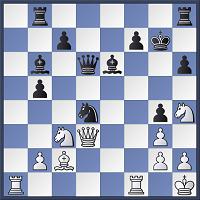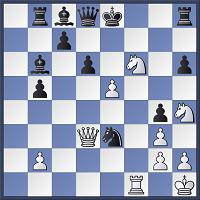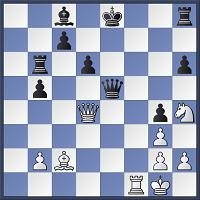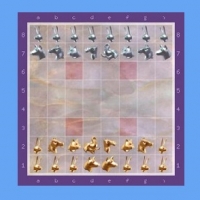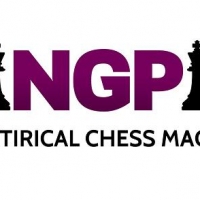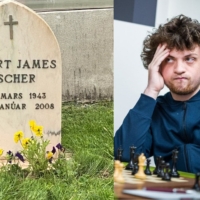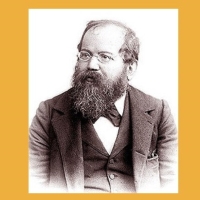Emil is one of the most inventive and flamboyant players in the world. Renowned for his romantic playing style and brilliant sacrificial attacks, he will be describing some of his best games exclusively for Kingpin.
Emil was born in Baku on 19 September 1977. He won the World Junior Chess Championship in 1996 and has represented Israel in eight Olympiads. At the 39th Olympiad in Khanty-Mansiysk in 2010 he achieved the highest tournament performance rating (2895) in the history of the event. He took the European Championship in 2001 and has won over 40 tournaments, notably the Aeroflot Open (2005). He is president of the Association of Chess Professionals and lives in Israel.
Emil Sutovsky – Alexei Shirov
9th Karpov Poikovsky 2008
Ruy Lopez
This game was played in the first round and due to the peculiarities of local hospitality I didn’t manage to prepare properly for it. Indeed, most of the players arrived in Poikovsky on the night before round one after a marathon journey. Poikovsky is a little town (or rather big village) in Western Siberia, so most of us had to fly to Moscow and take a three-hour connecting flight to Surgut followed by another two hours in a ‘chess’ bus. Instead of being allowed to rest after our long expedition we were taken to a banquet thrown by the region’s Governor and local sponsors. The atmosphere was very friendly, the meal delicious and the vodka was . . . well, I don’t know the correct adjective for a good vodka but it was excellent, even if the players couldn’t risk more than a shot or two. Unfortunately all this hardly helped my preparation, and the pairings weren’t announced until close to midnight. On the day of the game I intended to prepare for Shirov’s most likely openings but didn’t have enough time as I and GM Jakovenko had to represent the players at the official press conference.
As we shall see, I decided to repeat my home analysis, but . . .
GM Shirov has commented on this game for several magazines. I am in a stronger position than he was when he did this because I write with the benefit of having seen his notes.
1 e4 e5
One of his favourite moves. Of course, I had to be ready for 1…c5 as well.
2 Nf3 Nc6 3 Bb5 a6 4 Ba4 Nf6 5 0–0 b5 6 Bb3 Bc5 7 c3 d6 8 a4 Rb8 9 d4 Bb6 10 axb5 axb5 11 Qd3!
This move became popular after the Negi–Lahno match. It started to attract the attention of top players after White got an edge in a couple of the games. Later on Shirov improved on Black’s play and easily held against Adams. I also analysed it a lot and found a strong idea. Unfortunately the lines are so complex that I just couldn’t remember everything at the board.
11…0–0 12 Bg5 exd4 13 cxd4 h6 14 Bh4 g5 15 Bg3
Naturally 15 e5 suggests itself but it’s only a forced draw, as shown in the aforementioned Adams–Shirov game: 15 e5 gxh4 16 Qg6+ Kh8 17 Qxh6+ Nh7 18 Bc2 f5 19 exf6 Rf7 20 Ng5 Qxf6 21 Nxf7+ Qxf7 22 Bxh7 Qxh7 23 Qf8+ Qg8 24 Qh6+.
15…Nh5 16 Nc3!
I believe this is a novelty. White continues to develop, ignoring Black’s threats. Previously I had tried 16 Nbd2 against Avrukh but got no advantage.
16…Nxg3
This logical move is a mistake. Another optimistic way to play is 16…g4 but it also fails after 17 e5!. Black probably has to look at more modest ways to hold the position.
‘. . . most attacks can be parried or refuted and we evaluate such complications much more accurately than the top Grandmasters of 30–50 years ago. Isn’t that why there have been fewer and fewer remarkable games in recent years?’
17 fxg3
Quite a natural recapture. I can be proud of the fact that according to Shirov three strong Grandmasters (Shirov, Nisipeanu and Ganguly) missed my idea while preparing for an important match. I don’t really see anything extraordinary about it. The vitally important f-file is opened and White’s attack becomes very strong. Even if Fritz/Rybka totally dismissed 17 fxg3 I would check it.
17…g4
Black’s play is very consequent. Shirov claims this move is bad and proposes 17…Ne5 instead. I’d thoroughly analysed 17…Ne5 and proved that life is not rosy for Black here either (if only I could remember my analysis!). However, 17…g4 is by no means losing, as we shall see.
‘it’s a sign of the times to go for pawns rather than for mate’
18 e5
Shirov gives this move an exclamation mark but actually it’s the only move.
18…Kg7 19 Bc2 Rh8 20 Nh4 Nxd4
20…Nxe5 21 Qe4 is just losing for Black; 20…Be6!? 21 Kh1! would transpose to the line analysed below (21 Nxb5 is not so clear after 21…Nb4 22 Nf5+ (22 Qe4 Nxc2 23 exd6 Qg5) 22…Kf8 23 Qc3 Nxc2 24 Qxc2 Qd7 25 exd6 Qxb5 26 dxc7 Rc8 27 Kh1 Bxc7 and although White continues to create dangerous threats, Black should be able to parry all of them.

21 Rxf7+
‘Can you think of a recent game featuring a great sacrificial attack? Kasparov–Topalov, 1999? That was years ago.’
Shirov awards this a question mark. I don’t think the situation is so black and white and would rather punctuate it !??. Tal’s sacrifices were effective partly because in his day defence technique was far worse than it is now. Today we all know that most sacrifices do not work. People are no longer afraid to walk their king into the centre of the board and to expose him to discovered check. After thousands of hours spent analysing with mighty computer engines, we know that most attacks can be parried or refuted and we evaluate such complications much more accurately than the top Grandmasters of 30–50 years ago. Isn’t that why there have been fewer and fewer remarkable games in recent years? Can you think of a recent game featuring a great sacrificial attack? Kasparov–Topalov, 1999? That was years ago. Dozens of thousands (literally!) of games have been played by the top players since then.
Although Vishy Anand praised my beautiful combination against Gormally (see Kingpin 41), Fritz, Rybka and other animals have shown the refutation. But does it make the combination less beautiful? I don’t know the answer. Professor Elo probably did, for he rightly stressed that a player’s ranking reflects the number of points scored rather than the number of beautiful games played. Objectively 21 Kh1 was much stronger, and remarkably I had looked at it in my analysis. Well, such a quiet move is easy to forget. However, it is not winning. Shirov was probably too disgusted with his position or didn’t want to analyse it seriously, but whatever the reason his verdict that ‘Black is hopeless’ is a bit too strong.
After 21 Kh1 Be6 22 exd6 Qxd6
a) 22…Qd7 23 Rf4 Nxc2 (23…c5 24 Raf1) 24 Qxc2 cxd6 (24…b4 25 Ne4) 25 Raf1 is very bad for Black;
b) 22…Bc4 23 Qe4 Bxf1 24 Rxf1 Qg5 25 d7+-;
23 Nxb5! (a sign of the times: go for pawns rather than mate) 23…Nxb5 24 Nf5+! Bxf5 25 Qxf5 Qe6 (25…Qg6 26 Qf4! – the point! – 26…f5 27 Qe5+ Qf6 28 Qxb5 and pawns on f5 falls) 26 Qxb5 Be3 (26…Bd4 27 Qd3) 27 Qh5 (27 Qd3 Rbd8 28 Qc3+ Bd4 29 Qxc7 Rhe8 30 Bf5 Qe5 when Black has consolidated and should hold without great difficulty) 27…Rhf8 (27…Rxb2 28 Bf5 Qd5 29 Qxg4+ Bg5 30 Be4 Qe6 31 Rf5 Rb5 32 h4 Rxf5 33 Bxf5 Qe5 34 Ra4±) 28 Bf5 Qf6 29 Qxg4+ Kh8. Of course White is much better here but I wouldn’t call it hopeless or lost for Black, for example: 30 Bd3 Qg7 31 Qc4 Qd4 and I seriously doubt whether White can convert his advantage.
21…Kxf7
22 Rf1+?
This move is certainly too ambitious but at least I am consistent in my wrongheadedness. Of course I could play 22 Qg6+ Kf8 23 Rf1+ Nf3+ (for some reason Shirov analyses only 23…Nf5 but 23…Nf3 looks much more natural to me) 24 Kh1 Qg5 25 gxf3 Qxg6 26 Nxg6+ Kg7 27 Nxh8 Bb7 28 Be4 Bxe4 29 Nxe4 dxe5 30 fxg4 Rxh8 with a roughly equal ending, but I didn’t have this in mind when I sacrificed the rook on f7!
22…Ke8
22…Nf3+ 23 Kh1 would be just winning for White of course. The computer suggests 22…Ke6 but it looks wrong – though ‘looks wrong’ is not sufficient reason to dismiss the move. After 23 Kh1 White’s attack is very dangerous but there’s little sense in copy and pasting computer lines here.
‘I was surprised to hear Shirov accusing me of unethical behaviour. He thought it was rude of me to offer a draw since he had avoided repeating moves on move 31.’
23 Nd5
Shirov indicates 23 Qg6+ Kd7 24 Rf7+ (24 Qxg4+ Ne6+) 24…Kc6 25 Be4+ Kc5 as ‘comfortable’. I am not sure that’s the most precise description but it’s true that White can’t deliver mate, which is especially painful when you are playing a rook down.
23…Nf3+?
Natural but not the best. Once again the computer lines suggested by Alexei in his analysis are correct – but they are COMPUTER lines. Snatching the dangerous pawn on e5 with the knight is just a natural and human way to play and has nothing to do with a ‘patzer see a doublecheck. . . I am sure Shirov wouldn’t have played 23…Nf3+ unless he had 24…Nxe5 to follow! The most human winning line is 23…Nxc2+ 24 Kh1 Ne3 25 Nf6+
25…Qxf6! (surprisingly overlooked by Shirov and 25…Kf7 walking into discovered check it’s too siliconian to for mortals. . .) 26 Rxf6 Ra8 27 Qg6+ Kd8 28 Rxd6+ cxd6 29 Qxd6+ Bd7 30 Qxb6+ Kc8 31 h3 Ra1+ 32 Kh2 Nf1+ 33 Kg1 Re8 and Black will win. I have to admit that this line (especially the last quiet move) cannot pretend to be labelled ‘H’ (human): 23…Qg5 24 Nxb6 Rxb6 25 Qxd4 (25 Ng6 Rg8 26 Qxd4 Rxg6 27 Bxg6+ Qxg6 28 exd6 Rxd6 29 Qe5+ Kd8) 25…Qxe5 doesn’t look very convincing. In most of the lines Black is just in time but calling it ‘a trivial win’ is a bit of an exaggeration. White always has some compensation for exchange, though admittedly it’s insufficient here:
a) 26 Qd2 Qg5 27 Rf4 (27 Qd1 Kd8) 27…Ra6 28 h3 gxh3 29 Kh2 Rg8–+;
b) 26 Qf2 Qc5 27 Re1+ Kd7! (27…Kd8 28 Re3 Ra6! 29 h3 is just unclear) 28 Re3 Rf8.
c) 26 Qd1 Kd8 27 Ng6 Qc5+ 28 Kh1 Re8.
24 Kh1 Nxe5 25 Qxb5+
25…Bd7
25…c6 26 Bg6+ Kd7 27 Bf5+ Ke8 is just a draw, as 28 Bg6+ Nxg6 29 Qxc6+ Bd7 30 Qxd6 is suddenly losing for Black!
26 Qe2!
White has serious threats but unfortunately Black’s only defence is more than sufficient.
26…Qg5 27 Ng6
27…Bc6?
This one is a real mistake. After the correct 27…Be6 Black would have a serious advantage, even if I managed to find the best continuation: 28 Ndf4 (28 Nf6+ Kd8 29 Nxh8 Qg7 is just hopeless) 28…Bc4 29 Ba4+ Kd8 30 Qxc4 Nxc4 31 Ne6+ Kc8 32 Nxg5 hxg5 (32…Ne3!? 33 Re1 (the last-ditch attack doesn’t work: 33 Ne7+ Kb7 34 Bc6+ Ka6 35 Ra1+ Ba5 36 Ne6 Rh7! 37 Nxc7+ Kb6 and it’s over) 33…hxg5 34 Nxh8 Bd4 35 b3 c5 and Black has a good chances to convert his advantage) 33 Nxh8 Kb7 34 Nf7 Nxb2 35 Bb5 leaves White some practical chances to escape, but objectively it must be lost.
28 Rf5! Qc1+ 29 Rf1 Qg5 30 Rf5 Qc1+ 31 Rf1
31…Qxf1+!?
Black avoids from the threefold repetition, the position remains equal and is almost a forced draw.
32 Qxf1 Bxd5
33 Nxh8
33 Nxe5 Rf8 34 Qb5+ c6 35 Nxc6 Bxc6 36 Qxc6+ Ke7 was another drawish line. After 37 h3 (37 Bd3 Rbc8 38 Qe4+ Kd8 39 Qe1 Bf2 is insufficient and all attempts by both sides to play for a win here are easily refuted) 37…Rf1+ (37…gxh3? 38 Qe4+ Kd8 39 Qh4+ Kc7 40 Qe7+ Kc6 41 Be4+ Kc5 42 Qe6!y with a murderous attack) 38 Kh2 Bg1+ 39 Kh1 and Black has to take the perpetual as his king is too vulnerable.
33…Ke7 34 Ng6+ Nxg6 35 Bxg6
Here I offered a draw as the line played in the game is pretty obvious, so I was surprised to hear Shirov accusing me of unethical behaviour. He thought it was rude of me to offer a draw since he had avoided repeating moves on move 31. I see nothing wrong here as the perpetual is inevitable in a couple of moves. It’s not as if I had made a second draw offer or proposed a draw in a worse position. Anyway, the remaining moves just confirm my evaluation.
35…Rf8 36 Qb1
‘Excellent defensive move’ according to my opponent, but there was nothing wrong in 36 Qd3 leading to more or less the same drawish lines.
36…Kd8 37 h3 Rf2
37…gxh3 38 Be4 Bxe4 39 Qxe4 can’t be worse for White of course.
38 Be4 Bxe4 39 Qxe4 Rf1+ 40 Kh2 Bg1+
41 Kh1 Bf2+ 42 Kh2 Bg1+
A highly entertaining game. We both made mistakes but it was a real battle and I hope you enjoyed it. It won’t get into either of our best game collections but it’s a candidate for my memorable games shortlist. Romantic chess is alive and kicking, and I look forward to showing you more examples! ½–½





